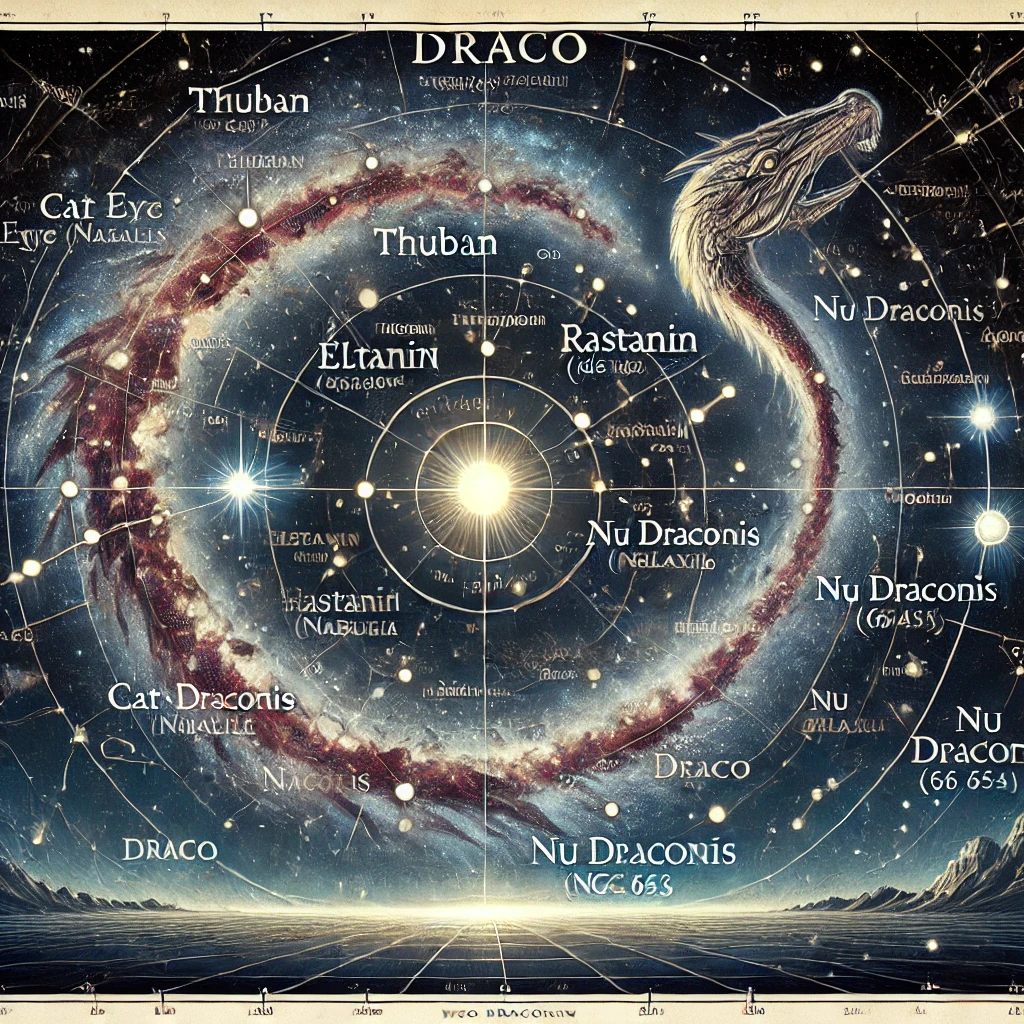The Draco constellation, Latin for “dragon,” is a large and prominent constellation in the northern sky. Draco is one of the 88 modern constellations recognized by the International Astronomical Union (IAU) and is notable for its winding shape that resembles a dragon coiling between the constellations of Ursa Major and Ursa Minor. Draco is visible throughout the year in the Northern Hemisphere and contains several fascinating deep-sky objects, including galaxies and planetary nebulae.
Astronomical Characteristics
- Abbreviation: Dra
- Genitive Form: Draconis
- Right Ascension: 8h 0m to 20h 0m
- Declination: +90° to +47°
- Visible Between Latitudes: +90° to -15°
- Best Viewing Time: June to September
- Area: 1083 square degrees (8th largest constellation)
- Neighboring Constellations: Ursa Major, Ursa Minor, Hercules, Lyra, Cepheus, Bootes, and Cygnus
Key Features of Draco
1. Brightest Stars
Draco contains many interesting stars, with the following being the most notable:
- Thuban (Alpha Draconis):
- Historically significant as Earth’s North Star around 3000 BCE due to Earth’s axial precession.
- Magnitude: 3.67
- Distance: Approximately 300 light-years from Earth.
- Thuban was used for navigation by ancient civilizations such as the Egyptians.
- Eltanin (Gamma Draconis):
- The brightest star in Draco, often called the ‘Dragon’s Eye.’
- Magnitude: 2.24
- Distance: Approximately 150 light-years from Earth.
- A giant star that has been extensively studied for its motion and properties.
- Rastaban (Beta Draconis):
- The second-brightest star, forming part of the dragon’s ‘head.’
- Magnitude: 2.79
- Distance: About 360 light-years away.
- Nu Draconis (Kuma):
- A double star system easily observed with binoculars.
- Magnitude: 4.88 and 4.89
2. Deep-Sky Objects in Draco
Draco is home to several deep-sky objects of interest to astronomers:
- NGC 6543 (Cat’s Eye Nebula):
- A well-known planetary nebula featuring intricate, concentric rings of gas.
- One of the most studied planetary nebulae due to its complex structure.
- Distance: Approximately 3,300 light-years.
- Abell 2218:
- A galaxy cluster that has been instrumental in gravitational lensing studies.
- Its gravitational field bends light from more distant galaxies behind it.
- Draco Dwarf Galaxy:
- A satellite galaxy of the Milky Way, rich in dark matter and composed mainly of older stars.
- Distance: Around 260,000 light-years.
- NGC 5866 (Messier 102):
- A lenticular galaxy sometimes mistaken for the Spindle Galaxy.
- Distance: Around 50 million light-years.
Mythology and Cultural Significance
Draco has a rich mythological background, with connections to multiple cultures:
- Greek Mythology:
In Greek myths, Draco is often identified with Ladon, the dragon that guarded the golden apples in the Garden of the Hesperides. The hero Heracles (Hercules) defeated the dragon as part of his Twelve Labors, and the gods placed Draco in the sky in recognition of its role. - Roman Interpretation:
The Romans associated Draco with a dragon defeated by the goddess Minerva during the Titanomachy (battle of the gods and Titans). - Norse and Other Legends:
In Norse mythology, the constellation has been linked to the serpent Nidhogg that gnaws at the roots of Yggdrasil, the world tree. - Chinese Astronomy:
In Chinese star lore, parts of Draco were incorporated into several different constellations within the ancient Chinese sky.
Observation Guide
Best Time to Observe:
- Draco is a circumpolar constellation, meaning it never sets below the horizon for observers in northern latitudes. It is best viewed in the summer months when it is high in the sky.
How to Locate Draco:
- Start by identifying the Big Dipper (Ursa Major) and follow the curve of its handle to locate Polaris (North Star) in Ursa Minor. Draco winds around between these two constellations.
- Look for a long, winding shape that coils around the Little Dipper.
Ideal Observing Conditions:
- Dark skies away from city lights are preferable to observe Draco’s fainter stars and deep-sky objects.
- Binoculars or a small telescope can help in viewing notable deep-sky objects like the Cat’s Eye Nebula.
Scientific and Astrophysical Significance
- Thuban’s Role as a Former Pole Star:
Due to Earth’s axial precession, Thuban was the North Star around 3000 BCE and will become the pole star again in about 20,000 years. - Studies of Draco Dwarf Galaxy:
This galaxy is an important subject for dark matter research, providing key insights into the composition of the universe. - Cat’s Eye Nebula Structure:
The complex and layered structure of NGC 6543 provides valuable data on stellar evolution and planetary nebula formation.
Interesting Facts About Draco
- Eighth Largest Constellation:
- Draco covers approximately 1083 square degrees of the sky, making it one of the largest constellations.
- Circumpolar Visibility:
- Draco can be seen all year round from northern latitudes, never dipping below the horizon.
- Connection to the Pyramids:
- Some theories suggest the ancient Egyptians aligned the pyramids with Thuban when it was the North Star.
- Meteor Showers:
- The Draconids meteor shower, occurring annually in October, originates from Draco and can produce spectacular outbursts.
Comparison with Nearby Constellations
| Constellation | Notable Feature | Relation to Draco |
|---|---|---|
| Ursa Major | The Big Dipper | Draco wraps around it |
| Ursa Minor | Contains Polaris (North Star) | Surrounded by Draco’s coils |
| Hercules | Bright star clusters | Shares part of the sky with Draco |
Conclusion
Draco is a fascinating constellation rich with mythology, deep-sky objects, and historical significance. Whether exploring its stars or tracing its mythological roots, Draco offers a rewarding experience for amateur and professional astronomers alike. Its presence in the night sky serves as a reminder of ancient celestial observations and our evolving understanding of the universe.

